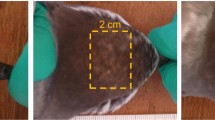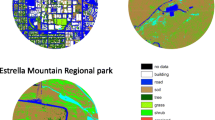Abstract
Carotenoid- and phaeomelanin-based sexual pigmentation may signal a capacity to maintain oxidative balance and viability. However, diverse empirical results leave the association between pigmentation and oxidative stress (OS) unclear. We assessed the hypothesis that population-specific levels of oxidative challenge, or strategies for managing OS, affect relationships between sexual pigmentation and OS. Specifically, intense oxidative challenge in migratory, temperate breeding birds might enhance correlations between pigmentation and OS relative to allied tropical breeders, since quality-based differences in OS may arise only under intense oxidative challenge. Alternatively, in temperate breeders with intense within-season reproductive effort, high-quality birds may invest in reproduction over oxidative balance, dampening negative correlations between pigmentation and OS. To assess these alternatives, we compared prenesting relationships between pigmentation and OS in a migratory, Californian population of yellow warblers (Setophaga petechia brewsteri) and in a resident, Mexican population (Setophaga petechia bryanti, “mangrove warblers”). Yellow warblers displayed higher OS than mangrove warblers. However, year of capture and sex had bigger influences on correlations between pigmentation and OS than population. Males with more intense melanin pigmentation had lower OS among mangrove warblers and yellow warblers captured in 2011, but not among yellow warblers captured in 2012. In females only, lower OS levels were associated with more colorful carotenoid pigmentation. Results suggest that both phaeomelanin- and carotenoid-based pigmentation have the potential to correlate with OS levels, but that the signaling potential of pigmentation may shift with inter-annual variation in environmental conditions and display sex-specific dynamics.




Similar content being viewed by others
References
Alonso-Alvarez C, Bertrand S, Devevey G, Prost J, Faivre B, Sorci G (2004a) Increased susceptibility to oxidative stress as a proximate cost of reproduction. Ecol Lett 7:363–368
Alonso-Alvarez C, Bertrand S, Devevey G, Gaillard M, Prost J, Faivre B, Sorci G (2004b) An experimental test of the dose-dependent effect of carotenoids and immune activation on sexual signals and antioxidant activity. Am Nat 164:651–659
Alonso-Alvarez C, Bertrand S, Faivre B, Chastel O, Sorci G (2007) Testosterone and oxidative stress: an oxidative handicap hypothesis. Proc R Soc Lond B 274:819–825
Alonso-Alvarez C, Perez-Rodriguez L, Mateo R, Chastel O, Viñuela J (2008) The oxidative handicap hypothesis and the carotenoid allocation trade-off. J Evol Biol 21:1769–1797
Alonso-Alvarez C, Galván I (2011) Free radical exposure causes paler carotenoid ornaments: a possible interaction in the expression of black and red traits. PLoS ONE 6:e19403
Andersson M, Prager M (2006) Quantifying color. In: Hill G, McGraw K (eds) Bird coloration, vol 1, Mechanisms and measurements. Harvard University Press, Cambridge, MA, pp 90–147
Badyaev A, Duckworth R (2003) Context-dependent sexual advertisement: plasticity in the development of sexual ornamentation throughout the lifetime of a passerine bird. J Evol Biol 16:1065–1076
Catoni C, Peters A, Schaefer M (2008) Life-history trade-offs are influenced by the diversity, availability and interactions of dietary antioxidants. Anim Behav 76:1107–1119
Cohen A, McGraw K, Wiersma P, Williams J, Robinson D, Robinson T, Brawn J, Ricklefs R (2008) Interspecific associations between circulating antioxidant levels and life-history variation in birds. Am Nat 172:178–193
Costantini D, Dell’Omo G (2006) Effects of T-cell-mediated immune response on avian oxidative stress. Comp Biochem Physiol A 145:137–142
Costantini D, Cardinale M, Carere C (2007) Oxidative damage and anti-oxidant capacity in two migratory bird species at a stop-over site. Comp Biochem Physiol 144:363–371
Costantini D, Møller A (2008) Carotenoids are minor antioxidants for birds. Funct Ecol 22:367–370
Costantini D, Verhulst S (2009) Does high antioxidant capacity indicate low oxidative stress? Funct Ecol 23:506–509
Cote J, Arnoux E, Sorci G, Gaillard M, Faivre B (2010) Age-dependent allocation of carotenoids to condition versus oxidative defenses. J Exp Biol 213:271–277
Galván I, Alonso-Alvarez C (2009) The expression of melanin-based pigmentation is separately modulated by exogenous oxidative stress and a melanocortin. Proc R Soc Lond B 276:3089–3097
Galván I, Alonso-Alvarez C (2011) Natural radioactivity can explain clinal variation in the expression of melanin-based traits. Evol Ecol 25:1197–1203
Galván I, Mousseau TA, Møller AP (2011) Bird population declines due to radiation exposure at Chernobyl are stronger in species with pheomelanin-based coloration. Oecologia 165:827–835
Galván I, Erritzøe J, Karadas F, Møller AP (2012) High levels of liver antioxidants are associated with life-history characteristics of slow growth and high survival rates in birds. J Comp Physiol B 182:947–959
Galván I, Møller AP (2013) Phaeomelanin-based coloration predicts survival rates in birds. Physiol Biochem Zool 86:000–000
Galván I, Solano F (2009) The evolution of eu- and pheomelanic traits may respond to an economy of pigments related to environmental oxidative stress. Pigm Cell Melanoma Res 22:339–342
Garratt M, Brooks R (2012) Oxidative stress and condition dependent sexual signals: more than just seeing red. Proc R Soc Lond B 279:3121–3130
Goymann W, Moore IT, Scheuerlein A, Hirschenhauser K, Grafen A, Wingfield JC (2004) Testosterone in tropical birds: effects of environmental and social factors. Am Nat 164:327–334
Grafen A (1990) Biological signals as handicaps. J Theor Biol 144:517–546
Harper D (1999) Feather mites, pectoral muscle condition, wing length, and plumage coloration of passerines. Anim Behav 58:553–562
Hegyi G, Szigeti B, Torok J, Eens M (2007a) Melanin, carotenoid, and structural plumage ornaments: information content and role in great tits Parus major. J Avian Biol 38:698–708
Hegyi G, Torok J, Garamszegi LZ, Rosivall B, Szollosi E, Hargitai R (2007b) Dynamics of multiple sexual signals in relation to climatic conditions. Evol Ecol Res 9:905–920
Horton BM, Yoon J, Ghalambor CK, Moore IT, Sillett TS (2010) Seasonal and population variation in male testosterone levels in breeding orange-crowned warblers (Vermivora celata). Gen Comp Endocr 168:333–339
Hunt J, Brooks R, Jennions M, Smith MJ, Bentsen C, Bussiére L (2004) High-quality male field crickets invest highly in sexual display but die young. Nature 432:1024–1027
Kokko H, Brooks R, McNamara JM, Houston AI (2002) The sexual selection continuum. Proc R Soc Lond B 269:1331–1340
Isaksson C, Andersson S (2008) Oxidative stress does not influence carotenoid mobilization and plumage pigmentation. Proc R Soc Lond B 275:309–314
Lindström J, Pike T, Blount J, Metcalfe N (2009) Optimization of resource allocation can explain the temporal dynamics and honesty of sexual signals. Am Nat 174:515–525
Losdat S, Helfenstein F, Gaude B, Richner H (2011) Reproductive effort transiently reduces antioxidant capacity in a wild bird. Behav Ecol 116:1–9
Lowther P, Celada C, Klein N, Rimmer C, Spector D (1999) Yellow warbler (Dendroica petechia). In: Poole A (ed) The Birds of North America Online. Cornell Laboratory of Ornithology, Ithaca, http://bna.birds.cornell.edu/bna/species/454doi:10.2173/bna.454
Marra PP, Holmes RT (2001) Consequences of dominance-mediated habitat segregation in American redstarts during the non-breeding season. Auk 118:92–104
McGraw KJ, Safran RJ, Evans MR, Wakamatsu K (2004) European barn swallows use melanin pigments to color their feathers brown. Behav Ecol 15:889–891
McGraw KJ, Safran RJ, Wakamatsu K (2005) How feather colour reflects its melanin content. Funct Ecol 19:816–821
Monaghan P, Metcalfe N, Torres R (2009) Oxidative stress as a mediator of life history trade-offs: mechanisms, measurements and interpretation. Ecol Lett 12:75–92
Montgomerie R (2006) Analyzing colors. In: Hill G, McGraw K (eds) Bird coloration, vol 1, Mechanisms and measurements. Harvard University Press, Cambridge, MA, pp 90–147
Parker T, Stansberry B, Becker C, Gipson P (2003) Do melanin- or carotenoid-pigmented plumage ornaments signal condition and predict pairing success in the Kentucky warbler? Condor 105:663–671
R Core Team (2012) R: a language and environment for statistical computing. R Foundation for Statistical Computing, Vienna, ISBN 3-900051-07-0; URL http://www.R-project.org/
Roulin A, Almasi B, Meichtry-Stier KS, Jenni L (2011) Eumelanin- and phaeomelanin-based colour advertise resistance to oxidative stress in opposite ways. J Evol Biol 24:2241–2247
Safran RJ, McGraw KJ (2004) Plumage coloration, not the length or symmetry of tail streamers, is a sexually selected trait in North American barn swallows. Behav Ecol 15:455–461
Saino N, Szep T, Ambrosini R, Romano M, Møller A (2004) Ecological conditions during winter affect sexual selection and breeding in a migratory bird. Proc R Soc Lond B 271:681–686
Salgado-Ortiz J, Marra P, Sillett T, Robertson R (2008) Breeding ecology of the mangrove warbler (Dendroica petechia bryanti) and comparative life history of the yellow warbler subspecies complex. Auk 125:402–410
Schulte-Hostedde AI, Zinner B, Millar JS, Hickling GJ (2005) Restitution of mass-size residuals: validating body condition indices. Ecology 86:155–163
Scordato E, Bontrager A, Price T (2012) Cross-generational effects of climate change on expression of a sexually selected trait. Curr Biol 22:78–82
Sillett TS, Holmes RT, Sherry TW (2000) Impacts of a global climate cycle on population dynamics of a migratory songbird. Science 288:2040–2042
Simons M, Cohen A, Verhulst S (2012) What does carotenoid-dependent coloration tell? plasma carotenoid level signals immunocompetence and oxidative stress state in birds—a meta-analysis. PLoS ONE 7:e43088
Studd MV, Robertson RJ (1988) Differential allocation of reproductive effort to territorial establishment and maintenance by male yellow warblers (Dendroica petechia). Behav Ecol Sociobiol 23:199–210
van de Crommenacker J, Komdeur J, Burke T, Richardson DS (2011) Spatio-temporal variation in territory quality and oxidative status: a natural experiment in the Seychelles warbler (Acrocephalus sechellensis). J Anim Ecol 80:668–680
Vergara P, Martinez-Padilla J, Mougeot F, Leckies F, Redpath S (2011a) Environmental heterogeneity influences the reliability of secondary sexual traits as condition indicators. J Evol Biol 25:20–28
Vergara P, Martinez-Padilla J, Redpath S, Mougeot F (2011b) The ornament-condition relationship varies with parasite abundance at population level in a female bird. Naturwissenschaften 98:897–902
Vitousek MN, Doi R, Safran RJ (2012) Sexual-signaling: climatic carry-over. Curr Biol 22:R61–R63
von Schantz T, Bensch S, Grahn M, Hasselquist D, Wittzell H (1999) Good genes, oxidative stress and condition-dependent sexual signals. Proc R Soc Lond B 266:1–12
Wiersma P, Selman C, Speakman J, Verhulst S (2004) Birds sacrifice oxidative protection for reproduction. Proc R Soc Lond B 271:S360–S363
Wiersma P, Muñoz-Garcia A, Walker A, Williams J (2007) Tropical birds have a slow pace of life. Proc Natl Acad Sci U S A 104:9340–9345
Wikelski M, Tarlow EM, Raim A, Diehl RH, Larkin RP, Visser GH (2003) Costs of migration in free-flying song birds. Nature 43:423–704
Williams J, Miller R, Harper J, Wiersma P (2010) Functional linkages for the pace of life, life-history, and environment in birds. Integr Comp Biol 50:855–868
Yezerinac S, Weatherhead P (1997) Extra-pair mating, male plumage coloration and sexual selection in yellow warblers (Dendroica petechia). P Roy Soc Lond B 264:527–532
Acknowledgments
We thank the Sierra Nevada Aquatic Research Laboratory (SNARL) and the Celestún field station of Ducks Unlimited Mexico (DUMAC) for providing facilities and access to field sites. Stephen J. Myers provided invaluable support by sponsoring the bird-banding subpermit (United States Geological Survey) essential to avian research in California. Jesús Vargas-Soriano (University of Campeche) provided critical field assistance, and David Costantini provided helpful advice on performing laboratory assays. Thanks also to Marlene Zuk, Daphne Fairbairn, Derek Roff and two anonymous reviewers for comments that aided in improving the manuscript. A National Science Foundation Doctoral Dissertation Improvement Grant to JTR and ASG, Sigma Xi, the University of California Natural Reserve System (Mildred E. Mathias Research Grant), and the Valentine Eastern Sierra Reserve provided funding.
Ethical standards and conflicts of interest
We conducted all procedures described in this manuscript in accordance with rigorous ethical and legal standards, and the University of California, Riverside’s institutional Animal Care and Use Committee approved all methods. The authors declare that they have no conflict of interest.
Author information
Authors and Affiliations
Corresponding author
Additional information
Communicated by K. McGraw
Electronic supplementary material
Below is the link to the electronic supplementary material.
ESM 1
DOCX 760 kb
Rights and permissions
About this article
Cite this article
Grunst, A.S., Salgado-Ortiz, J., Rotenberry, J.T. et al. Phaeomelanin- and carotenoid-based pigmentation reflect oxidative status in two populations of the yellow warbler (Setophaga petechia). Behav Ecol Sociobiol 68, 669–680 (2014). https://doi.org/10.1007/s00265-013-1681-8
Received:
Revised:
Accepted:
Published:
Issue Date:
DOI: https://doi.org/10.1007/s00265-013-1681-8




